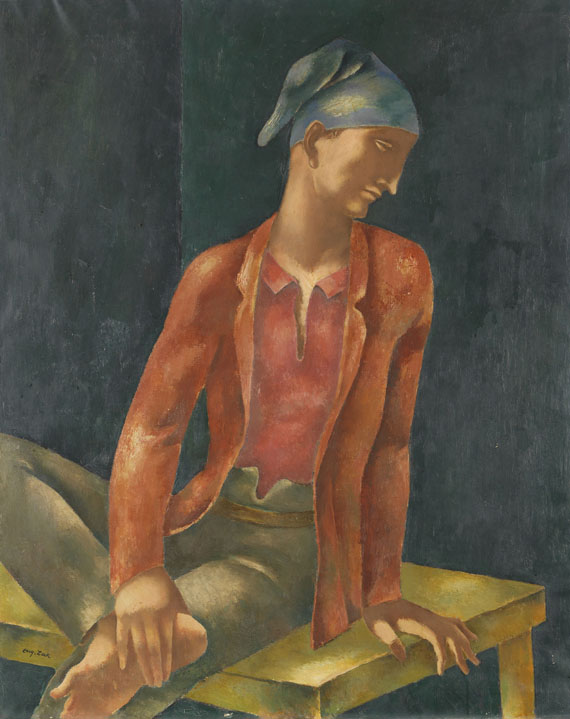253
Eugeniusz Zak
Junger Mann mit blauer Kappe, Um 1923.
Oil on canvas
Estimate:
€ 60,000 / $ 70,800 Sold:
€ 156,250 / $ 184,375 (incl. surcharge)
Junger Mann mit blauer Kappe. Um 1923.
Oil on canvas.
Lower left signed. 100 x 81 cm (39.3 x 31.8 in).
PROVENANCE: Private collection Southern Germany.
LITERATURE: H. Ritter, Ewige Romantik, in: Deutsche Kunst und Dekoration: illustr. Monatshefte für moderne Malerei, Plastik, Architektur, Wohnungskunst u. künstlerisches Frauen-Arbeiten, 1925, issue 56, p. 228 wit illu.
Barbara Brus-Malinowska, Eugeniusz Zak: 1884 - 1926, Warszawa 2004, p. 150, no. 196.
Oil on canvas.
Lower left signed. 100 x 81 cm (39.3 x 31.8 in).
PROVENANCE: Private collection Southern Germany.
LITERATURE: H. Ritter, Ewige Romantik, in: Deutsche Kunst und Dekoration: illustr. Monatshefte für moderne Malerei, Plastik, Architektur, Wohnungskunst u. künstlerisches Frauen-Arbeiten, 1925, issue 56, p. 228 wit illu.
Barbara Brus-Malinowska, Eugeniusz Zak: 1884 - 1926, Warszawa 2004, p. 150, no. 196.
The painter Eugeniusz Zak, an important representative of the École de Paris at the beginning of the 20th century, was born the son of an engineer of Jewish-Polish origin in Moligno, Belarus in 1884. After his father’s death the family relocated to Warsaw in 1892, where Eugeniusz Zak completed secondary school. In 1902 Zak moved to Paris where he studied art at the École des Beaux-Arts under Jean-Léon Gérôme, as well as at the Académie Colarossi at Albert Besnard. In 1903 Zak traveled to Italy and Munich, where he took lessons at the private art school of the Slovenian painter Anton Ažbes. In 1904 Eugeniusz Zak returned to Paris and exhibited his works at the autumn show of the Paris Salon. The graphic and pictorial creation of Eugeniusz Zak is dedicated to figuration and combines aspects of traditional and modern tendencies of the early 20th century.The early period of Zak's creation is characterized by portraits of common people, peasants and fishermen as well as of children and mothers. His drawings in gouache, red chalk and chalk show the influence of Zak's journeys to Brittany between 1906 and 1908. After the outbreak of the First World War Zak visited Southern France between 1914 and 1916. From these days onward he made pictures with idyllic scenes of loving couples, lone wanderers, fishermen and mothers in harmonious landscape settings that call reminiscence of works by artists such as Puvis de Chavannes and Cézanne. As of 1917 he developed an increasing interest in scenes of a surreal parallel existence inhibited by jesters, dancers, jugglers and other outsiders such as beggars and vagabonds. These works show the influence of Picasso's early paintings. Other sources of influences such as Expressionism or the socio-critical German New Objectivity can also be found. Zak's later works are characterized by neo-classicist tendencies. Among the works from these days we find classic portrait heads and Greek Contrapposto sculptures with stylized faces that call reminiscence of the masterpieces of Botticelli or Leonardo da Vinci. In Zak's creation they mark the dialog between tradition and the manifold styles of Modernism. Eugeniusz Zak's art was honored in many international solo shows and publications and was on display at various public collections, mostly in Poland. The Parisian Musée du Luxembourg acquired works by Eugeniusz Zak for its collection as early as in 1910. The same year Zak joined the Association of Polish Artists in Paris, other members were Elie Nadelman, Leopold Gottlieb and Mela Muter. In 1912 Zak was appointed professor at the Académie de la Palette, in 1913 he participated in the acclaimed International Exhibition of Modern Art in New York, the so-called Armory Show. In 1914 his first solo show at the renowned Parisian Galerie Druet followed. In 1916 Zak and his wife Jadwiga Kon, who he had married in Paris in 1913, returned to Czestochowa in Poland. In 1917 Zak participated in the first exhibition of 'Formizm', a Polish group of expressionist artists, in Cracow, in 1921 he was one of the founding members of the Polish group of artists called Rytm (Engish: Rhythm). In 1922 Eugeniusz Zak stayed in Berlin and Bonn for some time and eventually returned to Paris in 1923. The counter movement that set in after the Fauves and the German Expressionism put forth New Objectivity in Germany and a form of Neoromanticism in other countries, predominantly in France.The paintings formal arrangement calls reminiscence of Italian Late Renaissance and Picasso's early works. Thecoloring's shaded tone underlines the artist's intention to a closed form of arrangement. In a dreamlike lost world the artist's broaches the issue of the individual's isolation, as it can also be found in the art of Karl Hofer. Remote from all forms of Realism Zak sought to give the individual a special form of an own dignity that finds its fulfillment in a precise pictorial interpretation. Eugeniusz Zak died in Paris in 1926. [KD]
253
Eugeniusz Zak
Junger Mann mit blauer Kappe, Um 1923.
Oil on canvas
Estimate:
€ 60,000 / $ 70,800 Sold:
€ 156,250 / $ 184,375 (incl. surcharge)
Headquarters
Joseph-Wild-Str. 18
81829 Munich
Phone: +49 89 55 244-0
Fax: +49 89 55 244-177
info@kettererkunst.de
Louisa von Saucken / Undine Schleifer
Holstenwall 5
20355 Hamburg
Phone: +49 40 37 49 61-0
Fax: +49 40 37 49 61-66
infohamburg@kettererkunst.de
Dr. Simone Wiechers / Nane Schlage
Fasanenstr. 70
10719 Berlin
Phone: +49 30 88 67 53-63
Fax: +49 30 88 67 56-43
infoberlin@kettererkunst.de
Cordula Lichtenberg
Gertrudenstraße 24-28
50667 Cologne
Phone: +49 221 510 908-15
infokoeln@kettererkunst.de
Hessen
Rhineland-Palatinate
Miriam Heß
Phone: +49 62 21 58 80-038
Fax: +49 62 21 58 80-595
infoheidelberg@kettererkunst.de
We will inform you in time.




 Lot 253
Lot 253 
